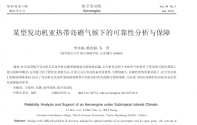This must be the very earliest versionMilitary buffs found some DATA of WS-10a in Naval Academy papers.
MTBF 150h
IFSD 0.1/1000EFH
Does anyone know similar indicator data for Russian and Western engines?
View attachment 101918
You are using an out of date browser. It may not display this or other websites correctly.
You should upgrade or use an alternative browser.
You should upgrade or use an alternative browser.
Chinese Engine Development
- Thread starter jackbh
- Start date
The number should be 9.29 billion RMB or US$1.33 billion. If each engine averaged US$5 plus million, there would be 250 +/- engines.According to this, Shenyang Liming's Aeroengine related business saw its revenue increase by 98.72% in first half of 2022. That would indicate close to doubling the production of WS-10 series and some WS-20. J-20's 2021 H1 production rate was probably at 30 per year, flankers were at 50 to 60 a year? and J-10 was at 30 a year. 2022 H1, I think production rate for J-20 maybe at 70 a year, flankers maybe at 70 a year a year and J-10 still at 30 a year. Maybe more spares are produced also?
The total revenue is said to be 92.9 billion RMB -> $13.3 billion. That seems like a lot if they produced 250 engines in half year even if we include servicing from previous years. Not really sure.
View attachment 101879
you are right! $5 million per engine would make a whole lot more sense here.The number should be 9.29 billion RMB or US$1.33 billion. If each engine averaged US$5 plus million, there would be 250 +/- engines.
What does this mean?IFSD 0.1/1000EFH
by78
General
Military buffs found some DATA of WS-10a in Naval Academy papers.
MTBF 150h
IFSD 0.1/1000EFH
Does anyone know similar indicator data for Russian and Western engines?
View attachment 101918
What's the context? When was this paper dated? Was there any original commentary accompanying the photo? Could you please provide a source or where you found this?
probably a decade old. WS-10A, that never went into mass production. WS-10A was basically a technological demonstrator.What's the context? When was this paper dated? Was there any original commentary accompanying the photo? Could you please provide a source or where you found this?
by78
General
Military buffs found some DATA of WS-10a in Naval Academy papers.
MTBF 150h
IFSD 0.1/1000EFH
Does anyone know similar indicator data for Russian and Western engines?
View attachment 101918
paper title
Reliability Analysis and Guarantee of a Certain Type of Engine in Subtropical Island and Reef Climate
A 2018 paper
View attachment 101959
I've read the full paper. Nowhere does it say the engine is WS-10A, so unless your source is an insider or has access to inside information, I would be careful in attributing the reliability numbers to WS-10A.
If I'm reading the paper correctly, the MTBF of 150 hours and in-flight-shutdown (IFSD) of ≤0.1 per 1000 flight hours are the navy's reliability requirements for this engine when operating in the harsh salty environment of the subtropics/tropics. However, the paper points out that they have not been able to meet these requirements –– actual MTBF and IFSD figures are 104.4 hours and 2.01/1000hr, respectively. Furthermore, the paper states that they will not be able to meet the requirements in the short term, and so in the meantime, the navy needs to figure out the provisioning rates and quantities of the various spare parts for repairing this type of engine in order to hit their aircraft availability goal.
P.S. It's important to keep in mind that MTBF depends on the definition of what constitutes a failure, which could be as small as the % of ball bearings needing replacement being above a defined threshold.


